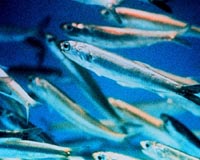| . |  |
. |
Silver Spring MD (SPX) Jul 02, 2010 The northern Gulf of Mexico hypoxic zone, an underwater area with little or no oxygen known commonly as the "dead zone," could be larger than the recent average, according to a forecast by a team of NOAA-supported scientists from the Louisiana Universities Marine Consortium, Louisiana State University, and the University of Michigan. Scientists are predicting the area could measure between 6,500 and 7,800 square miles, or an area roughly the size of the state of New Jersey. The average of the past five years is approximately 6,000 square miles. It is the goal of a federal state task force to reduce it to 1,900 square miles. The largest dead zone on record, 8,484 square miles, occurred in 2002. This forecast is based on Mississippi River nutrient flows compiled annually by the U.S. Geological Survey. Dead zones off the coast of Louisiana and Texas are caused by nutrient runoff, principally from agricultural activity, which stimulates an overgrowth of algae that sinks, decomposes, and consumes most of the life-giving oxygen supply in the water. It is unclear what impact, if any, the BP Deepwater Horizon oil spill will have on the size of the dead zone. "The oil spill could enhance the size of the hypoxic zone through the microbial breakdown of oil, which consumes oxygen, but the oil could also limit the growth of the hypoxia-fueling algae," said R. Eugene Turner, Ph.D., professor of oceanography at Louisiana State University. "It is clear, however, that the combination of the hypoxic zone and the oil spill is not good for local fisheries." Hypoxia is of particular concern because it threatens valuable commercial and recreational Gulf fisheries. In 2008, the dockside value of commercial fisheries was $659 million. The 24 million fishing trips taken in 2008 by more than three million recreational fishers further contributed well over a billion dollars to the Gulf economy. "As with weather forecasts, this prediction uses multiple models to predict the range of the expected size of the dead zone," said Robert Magnien, Ph.D., director of NOAA's Center for Sponsored Coastal Ocean Research. "The strong track record of these models reinforces our confidence in the link between excess nutrients from the Mississippi River and the dead zone." "The 2010 spring nutrient load transported to the northern Gulf of Mexico is about 11 percent less than the average over the last 30 years," said Matthew Larsen, Ph.D., USGS associate director for water. "An estimated 118,000 metric tons of nitrogen in the form of nitrate were transported in May 2010 to the northern Gulf." The collaboration among NOAA, USGS, and University scientists facilitates understanding of the linkages between activities in the Mississippi River watershed and the downstream effects on the northern Gulf of Mexico. Long-term data sets on nutrient loads and the extent of the hypoxic zone have improved forecast models used by management agencies to understand the nutrient reductions required to reduce the size of the hypoxic zone to the established goal. This year's forecast is an example of NOAA's growing ecological forecasting capabilities that allow for the protection of valuable resources using scientific, ecosystem-based approaches.
Share This Article With Planet Earth
Related Links NOAA's Center for Sponsored Coastal Ocean Research Our Polluted World and Cleaning It Up
 Why Mercury Is More Dangerous In Oceans
Why Mercury Is More Dangerous In OceansDurham NC (SPX) Jun 30, 2010 Even though freshwater concentrations of mercury are far greater than those found in seawater, it's the saltwater fish like tuna, mackerel and shark that end up posing a more serious health threat to humans who eat them. The answer, according to Duke University researchers, is in the seawater itself. The potentially harmful version of mercury - known as methylmercury - latches onto d ... read more |
|
| The content herein, unless otherwise known to be public domain, are Copyright 1995-2010 - SpaceDaily. AFP and UPI Wire Stories are copyright Agence France-Presse and United Press International. ESA Portal Reports are copyright European Space Agency. All NASA sourced material is public domain. Additional copyrights may apply in whole or part to other bona fide parties. Advertising does not imply endorsement,agreement or approval of any opinions, statements or information provided by SpaceDaily on any Web page published or hosted by SpaceDaily. Privacy Statement |